 One of the things about larger wineries that have lots of acreage under vine is that are often more grapes to work with. This can of course be an advantage on several levels. Primarily it allows the winemaker a wider selection from which to pick fruit for their most important wines. It can sometimes also allow the winemakers to take on projects outside the core releases. Such is the case with Carneros producer Artesa Vineyards & Winery. Those familiar with them know that Pinot Noir and Chardonnay stand at the heart of their operation. These are the core wines they focus on. But with hundreds of acres under vine they have many other grapes to work with. One of their current projects is the Elements by Artesa sub-label which they use to release some different varieties at a consumer friendly price-point. I recently tasted through the Elements releases and today I’ll look at three of my favorites.
First up is the Elements by Artesa 2006 Red Wine. This wine blends together fruit from Sonoma County (65%) and Napa Valley (35%). The fruit is made up of Cabernet Sauvignon (23%), Tempranillo (22%), Merlot (20%), Malbec (18%), Garnacha (11%), Petite Sirah (2%), Petit Verdot (2%), Graciano (1%), and Cabernet Franc (1%). Barrel aging was accomplished over 24 months in French oak. 4,400 cases of this wine were produced and it has a suggested retail price of $19.99.
One of the things about larger wineries that have lots of acreage under vine is that are often more grapes to work with. This can of course be an advantage on several levels. Primarily it allows the winemaker a wider selection from which to pick fruit for their most important wines. It can sometimes also allow the winemakers to take on projects outside the core releases. Such is the case with Carneros producer Artesa Vineyards & Winery. Those familiar with them know that Pinot Noir and Chardonnay stand at the heart of their operation. These are the core wines they focus on. But with hundreds of acres under vine they have many other grapes to work with. One of their current projects is the Elements by Artesa sub-label which they use to release some different varieties at a consumer friendly price-point. I recently tasted through the Elements releases and today I’ll look at three of my favorites.
First up is the Elements by Artesa 2006 Red Wine. This wine blends together fruit from Sonoma County (65%) and Napa Valley (35%). The fruit is made up of Cabernet Sauvignon (23%), Tempranillo (22%), Merlot (20%), Malbec (18%), Garnacha (11%), Petite Sirah (2%), Petit Verdot (2%), Graciano (1%), and Cabernet Franc (1%). Barrel aging was accomplished over 24 months in French oak. 4,400 cases of this wine were produced and it has a suggested retail price of $19.99.
Wild strawberry fills the welcoming nose of this 2006 red blend. Recurring wisps of candied cherry provide a nice aromatic counterbalance. The lithe, medium bodied palate shows off red and black fruits such as currant, blackberry and cherry. Vanilla and cherry cola flavors are both in evidence on the finish. This wine has some bright fruit elements but those are balanced by good acidity, structure and nice length. Ultimately this is a perfectly dry wine built to pair with food. Whether that means Sunday dinner or Tuesday night with a slice of pizza is your call, either way lots of flavor for the price point.
Next up is the Elements by Artesa 2007 Merlot. This wine was produced using fruit sourced in both Sonoma (64%) and Napa (36%). In addition to Merlot (75%), Cabernet Franc (12%), Cabernet Sauvignon (10%), Petite Sirah (1%), Petit Verdot (1%) and Syrah (1%) are also blended in. Each lot was fermented and barrel aged separately, the final blend was assembled prior to bottling. 3,000 cases of this release were produced and it has a suggested retail price of $19.99.
Red raspberry and rose petal aromas are both prominent in the nose of this 2007 Merlot. This Merlot shows a juicy, yet balanced mid-palate which is also slightly austere in some ways. Lots of red and black cherry are on display throughout, along with bits of rhubarb. The finish shows off leather, sour cherry and copious spice elements in the form of clove, nutmeg and pepper. This wine has excellent structure and good acidity. Sad as this is to say there’s not a lot of Merlot in the $20 price range that actually tastes like Merlot, this one does and that alone is an accomplishment. Overall this is a nice value.
Finally today is the Elements by Artesa 2006 Cabernet Sauvignon. Just like the other releases, this wine is made from a combination of fruit sourced in Sonoma (62%), and Napa (38%). In addition to Cabernet Sauvignon (86%), Merlot (7%), Cabernet Franc (4%), Petite Verdot (2%), and Malbec (1%) are also blended in. Barrel aging was accomplished over 24 months in French oak; 25% of the barrels were new. 8,000 cases of this wine were produced and it has a suggested retail price of $19.99.
A compote of red fruit aromas fills the nose of this Cabernet. Cherry, raspberry and strawberry are at the forefront with wisps of vanilla providing some nice secondary aromas. The palate is loaded with continued elements of red fruits. Juicy cherry and strawberry star along with lots of spice characteristics. Both black and white pepper emerge on the finish along with earth and dust characteristics as well as tobacco and espresso flavors. This wine has supple, yielding tannins and sufficient acidity. For around $20 you’re going to get a very tasty Cabernet Sauvignon that is best suited for short term drinking.
This trio of wines from Elements by Artesa provides plenty of pleasurable drinking for the price point. Equally important, the Merlot and Cabernet are true to their varietals. The blend, as it should, combines attributes from a diverse array of fruits to create something unique.
 Lately the white varietal out of Argentina that’s been getting a lot of attention is Torrontes. Rightly so in some ways as this is something Argentina offers that no one else really does. Sauvignon Blanc on the other hand is available from many of the world’s great wine making countries. That said there are some excellent and unique expressions of this classic grape coming out of Argentina and they deserve their due. Today I’ll look at one from Bodega Luigi Bosca, a producer I’ve found to be very reliable over the last few years.
The Luigi Bosca 2009 Reserva Sauvignon Blanc was produced from fruit sourced at the El Paraiso Vineyard in the Maipu section of Mendoza. This vineyard sits at 780 meters above sea level. This wine is 100% Sauvignon Blanc. After fermentation this wine spent 3 months aging in oak. This Sauvignon Blanc has a suggested retail price of $20.99.
Lately the white varietal out of Argentina that’s been getting a lot of attention is Torrontes. Rightly so in some ways as this is something Argentina offers that no one else really does. Sauvignon Blanc on the other hand is available from many of the world’s great wine making countries. That said there are some excellent and unique expressions of this classic grape coming out of Argentina and they deserve their due. Today I’ll look at one from Bodega Luigi Bosca, a producer I’ve found to be very reliable over the last few years.
The Luigi Bosca 2009 Reserva Sauvignon Blanc was produced from fruit sourced at the El Paraiso Vineyard in the Maipu section of Mendoza. This vineyard sits at 780 meters above sea level. This wine is 100% Sauvignon Blanc. After fermentation this wine spent 3 months aging in oak. This Sauvignon Blanc has a suggested retail price of $20.99.
 Lodi California is a name that anyone who drinks Zinfandel will immediately recognize. There are oodles of Zins emanating from that region on store shelves all over the country. There can be so many that it’s hard to pick one without a guide sometimes. When Zinfandel from Lodi is done right it can be an excellent expression of the varietal and thus they’re well worth exploring. Today I’ll look at the current release of Brazin.
The
Lodi California is a name that anyone who drinks Zinfandel will immediately recognize. There are oodles of Zins emanating from that region on store shelves all over the country. There can be so many that it’s hard to pick one without a guide sometimes. When Zinfandel from Lodi is done right it can be an excellent expression of the varietal and thus they’re well worth exploring. Today I’ll look at the current release of Brazin.
The  In the world of Champagne there are a small handful of truly classic names;
In the world of Champagne there are a small handful of truly classic names;  There’s a lot of delicious and fascinating wine coming out of Chile. The varieties available run the gamut. Not the least of them is Carmenere. More and more examples of this varietal are appearing on our shelves and they’re starting to gain some traction with wine lovers. Like a lot of what’s coming out of South America as a whole, and Chile in particular, Carmenere can often represent terrific values. Today I’ll look at one from the Rapel Valley.
The
There’s a lot of delicious and fascinating wine coming out of Chile. The varieties available run the gamut. Not the least of them is Carmenere. More and more examples of this varietal are appearing on our shelves and they’re starting to gain some traction with wine lovers. Like a lot of what’s coming out of South America as a whole, and Chile in particular, Carmenere can often represent terrific values. Today I’ll look at one from the Rapel Valley.
The 
 Pinot Noir remains one of the trickiest varieties in the world. There are a host of reasons for this. It prospers in some areas and doesn’t do well at all in others. Sometimes a couple areas in question can be quite close to each other, relatively speaking. But aside from the regions and sub-regions where Pinot either thrives or not there are questions of intent. While there are folks passionate about just every grape in the world, Pinot Noir has a particularly dedicated legion of believers. The treatment of the grapes and the style it’s produced in garners as much praise or criticism as the location it’s from. For most of those passionate about Pinot that means things like restrained use of oak and wines that are 100% varietal to name but a couple. One of the regions in the world where Pinot Noir thrives and is produced in a variety of styles is Oregon’s Willamette Valley. Today I’ll look at a current release from
Pinot Noir remains one of the trickiest varieties in the world. There are a host of reasons for this. It prospers in some areas and doesn’t do well at all in others. Sometimes a couple areas in question can be quite close to each other, relatively speaking. But aside from the regions and sub-regions where Pinot either thrives or not there are questions of intent. While there are folks passionate about just every grape in the world, Pinot Noir has a particularly dedicated legion of believers. The treatment of the grapes and the style it’s produced in garners as much praise or criticism as the location it’s from. For most of those passionate about Pinot that means things like restrained use of oak and wines that are 100% varietal to name but a couple. One of the regions in the world where Pinot Noir thrives and is produced in a variety of styles is Oregon’s Willamette Valley. Today I’ll look at a current release from 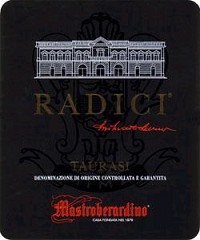 Aglianico is one of the Italian grapes that I’ve been pretty excited about the last few years. It’s a unique variety that flourishes in its homeland and we’ve been seeing more and more examples of it on US shelves as time goes on. And while our history of Aglianico in the US is pretty short, its story in Italy dates back a couple of thousand years. Today I’ll look at one from long time producer Mastroberardino.
The Mastroberardino 2005 Radici Taurasi was produced using fruit sourced from two vineyards. These vineyards sit approximately 1,800 feet above sea level. This offering is 100% Aglianico. Fermentation took place over 15 days in stainless steel tanks. Aging took place in barriques and casks of varying size and age. French and Slavonian oak were both employed; new, 2 year and 3 years barrels were all part of the program. 80,000 bottles (approximately 6,600 cases) of this wine were produced. It has a suggested retail price of $65
Aglianico is one of the Italian grapes that I’ve been pretty excited about the last few years. It’s a unique variety that flourishes in its homeland and we’ve been seeing more and more examples of it on US shelves as time goes on. And while our history of Aglianico in the US is pretty short, its story in Italy dates back a couple of thousand years. Today I’ll look at one from long time producer Mastroberardino.
The Mastroberardino 2005 Radici Taurasi was produced using fruit sourced from two vineyards. These vineyards sit approximately 1,800 feet above sea level. This offering is 100% Aglianico. Fermentation took place over 15 days in stainless steel tanks. Aging took place in barriques and casks of varying size and age. French and Slavonian oak were both employed; new, 2 year and 3 years barrels were all part of the program. 80,000 bottles (approximately 6,600 cases) of this wine were produced. It has a suggested retail price of $65  There is so much Cabernet Sauvignon coming out of Napa Valley that it can be a bit dizzying. It’s hard, heck it’s practically impossible, to visit a winery in Napa without tasting Cabernet. They come in all shapes, sizes and price-points, so for me examples that over-deliver in their price-bracket are noteworthy. Today I’m looking at such an example from Waterstone.
The
There is so much Cabernet Sauvignon coming out of Napa Valley that it can be a bit dizzying. It’s hard, heck it’s practically impossible, to visit a winery in Napa without tasting Cabernet. They come in all shapes, sizes and price-points, so for me examples that over-deliver in their price-bracket are noteworthy. Today I’m looking at such an example from Waterstone.
The 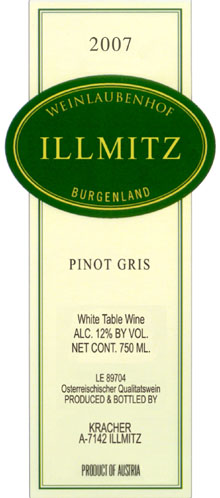 Pinot Gris is one of those varieties that, for my money, doesn’t get nearly the acclaim it deserves. Sure like any other varietal there are some forgettable examples out there. But when the fruit is grown in the right spot and the winemaker treats it with respect, the results can be dazzling. For Pinot Gris this mostly means a handful of spots in Germany, Oregon, Italy and Austria in my opinion. Today I’ll look at a release from Austria.
The
Pinot Gris is one of those varieties that, for my money, doesn’t get nearly the acclaim it deserves. Sure like any other varietal there are some forgettable examples out there. But when the fruit is grown in the right spot and the winemaker treats it with respect, the results can be dazzling. For Pinot Gris this mostly means a handful of spots in Germany, Oregon, Italy and Austria in my opinion. Today I’ll look at a release from Austria.
The 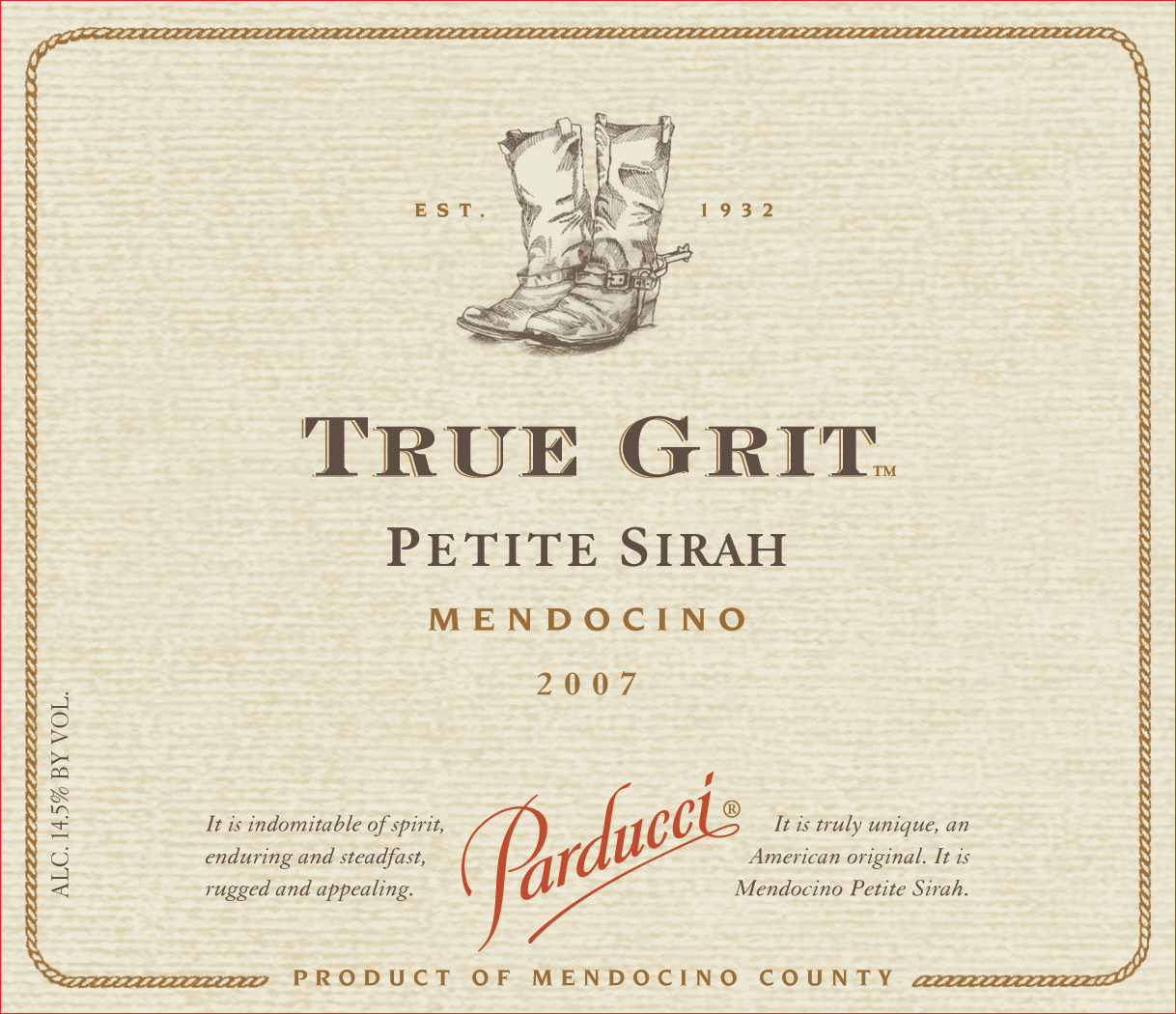 Mendocino’s
Mendocino’s 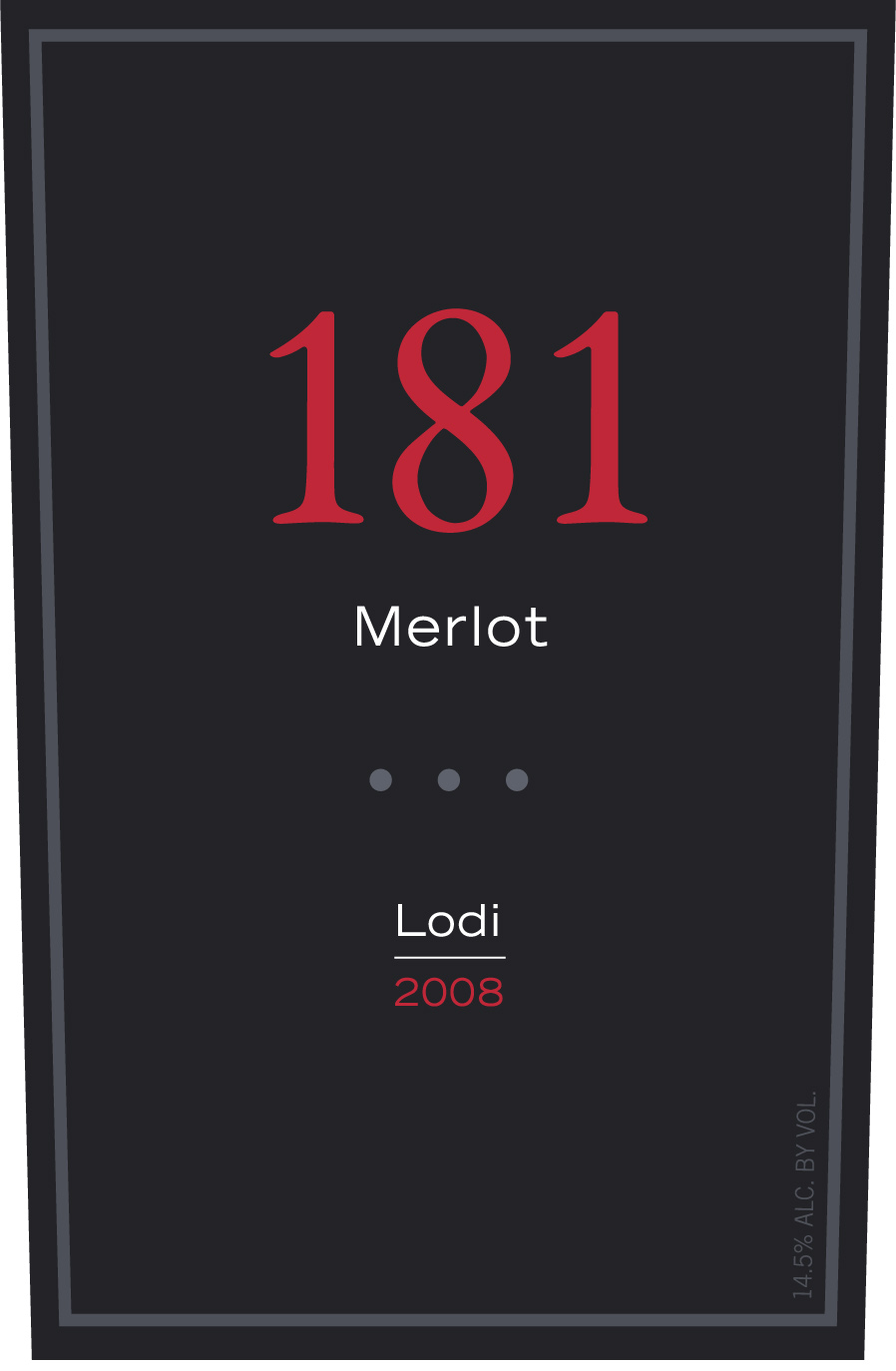 The
The  One of the things about larger wineries that have lots of acreage under vine is that are often more grapes to work with. This can of course be an advantage on several levels. Primarily it allows the winemaker a wider selection from which to pick fruit for their most important wines. It can sometimes also allow the winemakers to take on projects outside the core releases. Such is the case with Carneros producer
One of the things about larger wineries that have lots of acreage under vine is that are often more grapes to work with. This can of course be an advantage on several levels. Primarily it allows the winemaker a wider selection from which to pick fruit for their most important wines. It can sometimes also allow the winemakers to take on projects outside the core releases. Such is the case with Carneros producer  For the last few years table wines from Portugal have been gaining momentum on our shelves and our collective consciousness. Of course there’s still a ton of excellent Port coming from there too, but everyone knows that, right? Hopefully 2011 will be the year that these dry wines turn the corner and gain even greater acceptance here. The more we learn to appreciate them as a wine drinking country, the more and more we’ll see great ones on our shelves. Today I look at a Reserve release from Quinta do Vallado.
The
For the last few years table wines from Portugal have been gaining momentum on our shelves and our collective consciousness. Of course there’s still a ton of excellent Port coming from there too, but everyone knows that, right? Hopefully 2011 will be the year that these dry wines turn the corner and gain even greater acceptance here. The more we learn to appreciate them as a wine drinking country, the more and more we’ll see great ones on our shelves. Today I look at a Reserve release from Quinta do Vallado.
The 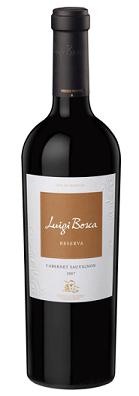 Cabernet Sauvignon is the varietal I was drinking most often when South American wines hit my radar years ago. Once I started drinking wines specifically from Argentina the quality of Cabernet available at modest price points was pretty staggering. Today our shelves have a host of offerings from Argentina all over the price and flavor map. One Producer I’ve been enjoying routinely over the last few years is Luigi Bosca. Today I’ll look at their current release of Cabernet Sauvignon.
The
Cabernet Sauvignon is the varietal I was drinking most often when South American wines hit my radar years ago. Once I started drinking wines specifically from Argentina the quality of Cabernet available at modest price points was pretty staggering. Today our shelves have a host of offerings from Argentina all over the price and flavor map. One Producer I’ve been enjoying routinely over the last few years is Luigi Bosca. Today I’ll look at their current release of Cabernet Sauvignon.
The  With the end of the year near my mind and my appetite is still pretty focused on Sparkling Wine.
With the end of the year near my mind and my appetite is still pretty focused on Sparkling Wine. 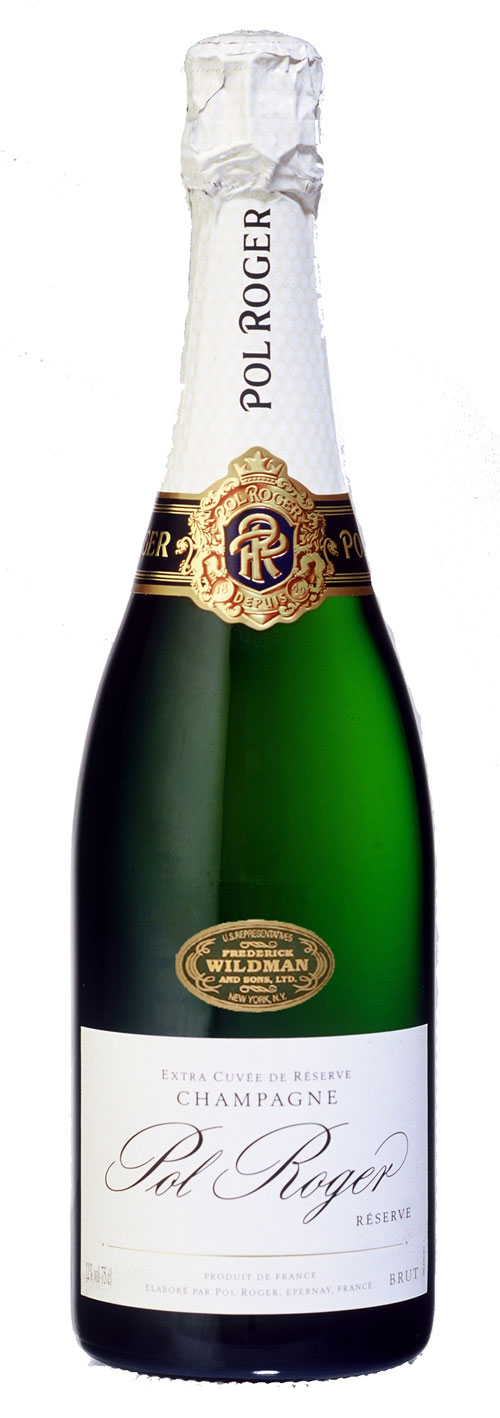 First up is the Pol Roger Brut Reserve “White Foil” (NV). This wine is a blend of equal parts Chardonnay, Pinot Noir and Pinot Meunier. All the fruit was sourced in sub appellations of the Champagne region. After crushing the grapes are fermented separately at cool temperature. When the final blends are assembled at least 2 vintages are represented and the wine ages a minimum of 3 years prior to release. This offering has a suggested retail price of $55. A host of aromas leap from the nose of this Non Vintage Brut; candied ginger, clover honey, almond, hazelnut, citrus and a hint of yeast are the most prominent. The full flavored palate is loaded with character and flavors such as lemongrass, hints of peach and a nice wallop of spices. The finish is crisp, layered and gentle with light yeast notes and continued spice that lingers persistently. This is a terrific example of NV Brut that blows away its price point by a fair clip.
First up is the Pol Roger Brut Reserve “White Foil” (NV). This wine is a blend of equal parts Chardonnay, Pinot Noir and Pinot Meunier. All the fruit was sourced in sub appellations of the Champagne region. After crushing the grapes are fermented separately at cool temperature. When the final blends are assembled at least 2 vintages are represented and the wine ages a minimum of 3 years prior to release. This offering has a suggested retail price of $55. A host of aromas leap from the nose of this Non Vintage Brut; candied ginger, clover honey, almond, hazelnut, citrus and a hint of yeast are the most prominent. The full flavored palate is loaded with character and flavors such as lemongrass, hints of peach and a nice wallop of spices. The finish is crisp, layered and gentle with light yeast notes and continued spice that lingers persistently. This is a terrific example of NV Brut that blows away its price point by a fair clip. Finally we come to the Pol Roger 1999 Brut Blanc de Blancs. This offering was produced from 100% Chardonnay sourced in Grand Cru vineyards around Champagne. Each lot is aged separately in stainless steel followed by blending and bottling. It then ages in the Pol Roger cellars for 7 years prior to release. This Vintage Champagne has a suggested retail price of $130. This wine has a gorgeous straw color. The nose is welcoming with hints of smoke, brioche and flowers. Apple and orchard fruit in general emerge on the palate which is creamy and ethereal. They’re joined by hazelnut and almond flavors as well as spice. The finish is amazingly layered and complex with minerals, spice, yeast and more. After swallowing a sip the flavors seem to continue forever. This wine is fresh and vibrant and really at the very beginning of its drinkable life cycle. There are champagnes in this price range that have bigger names, this selection from Pol Roger may not be quite as well known to the general consumer but it should be. It’s got impressive flavors, depth and complexity to spare. In short a lot of wow factor going on here. Value in my opinion is relative to quality provided. In this case the 1999 Blanc de Blancs from Pol Roger is a relative steal at $130.
Finally we come to the Pol Roger 1999 Brut Blanc de Blancs. This offering was produced from 100% Chardonnay sourced in Grand Cru vineyards around Champagne. Each lot is aged separately in stainless steel followed by blending and bottling. It then ages in the Pol Roger cellars for 7 years prior to release. This Vintage Champagne has a suggested retail price of $130. This wine has a gorgeous straw color. The nose is welcoming with hints of smoke, brioche and flowers. Apple and orchard fruit in general emerge on the palate which is creamy and ethereal. They’re joined by hazelnut and almond flavors as well as spice. The finish is amazingly layered and complex with minerals, spice, yeast and more. After swallowing a sip the flavors seem to continue forever. This wine is fresh and vibrant and really at the very beginning of its drinkable life cycle. There are champagnes in this price range that have bigger names, this selection from Pol Roger may not be quite as well known to the general consumer but it should be. It’s got impressive flavors, depth and complexity to spare. In short a lot of wow factor going on here. Value in my opinion is relative to quality provided. In this case the 1999 Blanc de Blancs from Pol Roger is a relative steal at $130. First up is the Swanson 2009 Pinot Grigio. Fruit for this release was sourced at the home estate on the Oakville Crossroad and in Santa Barbara. This wine was cold fermented and aged in stainless steel. 6,250 cases of this wine were produced and it has a suggested retail price of $21. The nose of this wine shows of hints of honey which lead to scores of lychee and passion fruit. The palate of this wine is impressively layered and complex for its category. Stone fruits dominate along with hints of orchard fruit and an underlying citrus component. These all lead into the unctuous finish which has hints of orange, vanilla bean, and spice. The finish is crisp and refreshing, inviting you back for more. There is a lot of unimpressive Pinot Grigio both in California and all over the world quite frankly. The Swanson Pinot Grigio however is cut from a different cloth. Year after year, vintage after vintage, it impresses and blows away its price point. Is it the best Pinot Grigio in California? Taste it and decide for yourself. No question though, it’s in the running.
First up is the Swanson 2009 Pinot Grigio. Fruit for this release was sourced at the home estate on the Oakville Crossroad and in Santa Barbara. This wine was cold fermented and aged in stainless steel. 6,250 cases of this wine were produced and it has a suggested retail price of $21. The nose of this wine shows of hints of honey which lead to scores of lychee and passion fruit. The palate of this wine is impressively layered and complex for its category. Stone fruits dominate along with hints of orchard fruit and an underlying citrus component. These all lead into the unctuous finish which has hints of orange, vanilla bean, and spice. The finish is crisp and refreshing, inviting you back for more. There is a lot of unimpressive Pinot Grigio both in California and all over the world quite frankly. The Swanson Pinot Grigio however is cut from a different cloth. Year after year, vintage after vintage, it impresses and blows away its price point. Is it the best Pinot Grigio in California? Taste it and decide for yourself. No question though, it’s in the running. Finally we come to the Swanson 2007 Alexis Cabernet Sauvignon. This wine was produced from fruit entirely sourced at the Schmidt Ranch in Napa Valley. In addition to Cabernet Sauvignon (81%), some Merlot (19%) is also blended in. Barrel aging took place over 22 months in all French oak; 60% of them were new. 500 cases of this wine were produced and it has a suggested retail price of $75. Alexis started life as a proprietary blend of mostly Cabernet with a generous dollop of Syrah and Merlot blended in. A few vintages back it shifted gears a bit and became a varietal Cabernet Sauvignon. Black cherry aromas are prominent in the nose of this wine. A hint of vanilla bean and a touch of eucalyptus are present as well. The palate is loaded with deep, dark berry fruit flavors. Cherry is prominent here as well, along with blackberry and black raspberry. Dark chocolate and hints of kirsch liqueur emerge in the finish along with oodles of earth that keeps coming and coming. The finish on this Cabernet Sauvignon is impressive to say the least. It has length and structure to spare. This wine is delicious now, but it’s really just a baby. If you’re patient and have proper storage conditions I would recommend laying it down for about 10 years and drinking it in the 5 or so years that follow. There’s a lot of very good Cabernet Sauvignon in Napa Valley. Alexis from Swanson is one of the very best in it’s price category. And while $75 may not be an everyday bottle for most, this is an excellent choice to tuck away for special occasions.
Finally we come to the Swanson 2007 Alexis Cabernet Sauvignon. This wine was produced from fruit entirely sourced at the Schmidt Ranch in Napa Valley. In addition to Cabernet Sauvignon (81%), some Merlot (19%) is also blended in. Barrel aging took place over 22 months in all French oak; 60% of them were new. 500 cases of this wine were produced and it has a suggested retail price of $75. Alexis started life as a proprietary blend of mostly Cabernet with a generous dollop of Syrah and Merlot blended in. A few vintages back it shifted gears a bit and became a varietal Cabernet Sauvignon. Black cherry aromas are prominent in the nose of this wine. A hint of vanilla bean and a touch of eucalyptus are present as well. The palate is loaded with deep, dark berry fruit flavors. Cherry is prominent here as well, along with blackberry and black raspberry. Dark chocolate and hints of kirsch liqueur emerge in the finish along with oodles of earth that keeps coming and coming. The finish on this Cabernet Sauvignon is impressive to say the least. It has length and structure to spare. This wine is delicious now, but it’s really just a baby. If you’re patient and have proper storage conditions I would recommend laying it down for about 10 years and drinking it in the 5 or so years that follow. There’s a lot of very good Cabernet Sauvignon in Napa Valley. Alexis from Swanson is one of the very best in it’s price category. And while $75 may not be an everyday bottle for most, this is an excellent choice to tuck away for special occasions.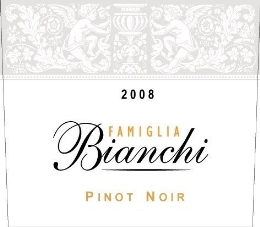 The
The 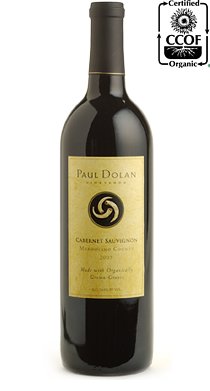 Last month I had the opportunity to spend some time in Mendocino. More than that, I was lucky enough to share a good chunk of time with Paul Dolan and other members of his team. Tasting wine is one thing, seeing the way an operation is run, literally from the ground up a whole other. What Paul Dolan is accomplishing in Mendocino both under his label and the Parducci brand is impressive to say the least. The dedication to Organics, sustainability and Biodynamics is admirable and incredibly genuine. Their pursuit of pure wines that express a sense of place is their drive. That they do so as shepherds of land they wish to leave in better condition than they found it is the icing on the cake, and then some. Today I’ll take a look at the most current release of Cabernet Sauvignon from Paul’s label.
The
Last month I had the opportunity to spend some time in Mendocino. More than that, I was lucky enough to share a good chunk of time with Paul Dolan and other members of his team. Tasting wine is one thing, seeing the way an operation is run, literally from the ground up a whole other. What Paul Dolan is accomplishing in Mendocino both under his label and the Parducci brand is impressive to say the least. The dedication to Organics, sustainability and Biodynamics is admirable and incredibly genuine. Their pursuit of pure wines that express a sense of place is their drive. That they do so as shepherds of land they wish to leave in better condition than they found it is the icing on the cake, and then some. Today I’ll take a look at the most current release of Cabernet Sauvignon from Paul’s label.
The 